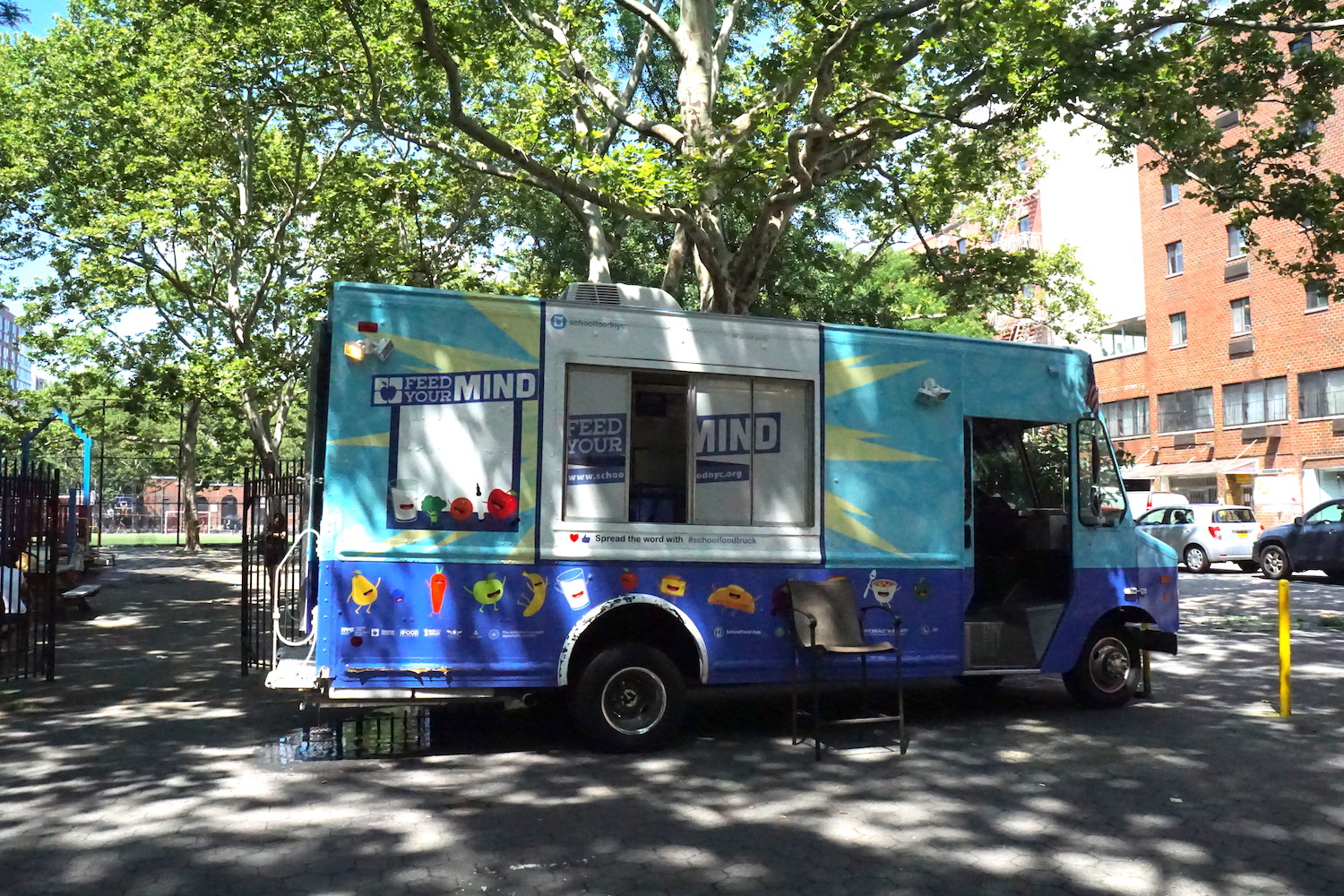
Jessica Fu
Last week, public schools across the country closed their doors for the summer. For some students, the break is a months-long period of tranquility and freedom, a long-awaited respite from the anxieties and rigidity of school days. But for many, the summer holiday is a vulnerable period of food insecurity, too.
According to the United States Department of Agriculture (USDA), more than 30 million students participate in free or reduced-price lunch (FRPL) and more than 14 million participate in free or reduced-price breakfast under the School Breakfast Program (SBP) during the school year. That’s 30 million students who rely on their schools for at least one meal a day. But when they’re not in class, many of these students face what is known as the “summer nutrition gap”: the struggle to secure enough food when school is not in session—and one that often puts undernourished students at an academic disadvantage when they return to classrooms in the fall.
In New York City—also known as “appetite city,” and the most populous in the country—the Department of Education (DOE) has found a means for reaching students during the summer in the most NYC way possible: food trucks.
−
On the first day of her summer break, Angelica Carballo, age 5, approaches one of the city’s summer food trucks for lunch. The truck, located in the middle of Sara D. Roosevelt Park on the Lower East Side of Manhattan, is an unmistakable shade of bright blue, adorned with cute illustrations of smiling fruits and vegetables. Carballo is handed a white paper bag, the contents of which she promptly spills across a picnic table. There’s a sandwich, a carton of orange juice, a plastic bag of carrots, and two single-serve packets—one of mayonnaise and another of mustard.
“I always use the food truck when I don’t have money and I’m hungry,” Carballo says, jumping up and down in her seat. Her favorites from today’s lunch bag are the milk and juice, a carton of which she demands that her sister Deinise, age 14, open immediately.
The Carballos live down the block from the park, making it a convenient option for lunch. The two sisters visit every day, but only Angelica eats from from the food truck regularly.
“I don’t like school lunch like that,” Deinise says, meaning she prefers hot food.
A walk around the park finds a number of other children who are relying on the food truck to varying degrees.
There’s Melchior, who doesn’t want to share his last name. He is five years old and visits about twice a month, whenever he’s at the playground with his babysitter, Rózsa. When asked what he likes about the food trucks, Melchior’s answer is simple: “Everything.”
At another table sits Weiying Zhang, who brings her two sons, ages 2 years and 8 months, to the food truck around twice a week. She lives farther from the park, which makes it harder to get here every day.
“It’s a kind of pleasure, my children like it. They approach the food truck with outstretched arms,” Zhang says in Mandarin Chinese. “Over a long period of time, it would help save money, but for me, I don’t use it that frequently.”
New York City’s DOE runs the largest school system in the country, serving over 1.1 million students across nearly 2,000 schools. The city also faces a high rate of child poverty. In 2016, an average of 53 percent of all children across the five boroughs lived in or near the city’s poverty guideline, which sits at $32,402 for a two- adult, two-child family. The federal poverty guideline, by comparison, is currently at $25,100.
 NYC Mayor's Office
NYC Mayor's Office New York City’s poverty guideline is higher than the federal poverty guideline due to the city’s higher cost of living
Efforts to close the summer nutrition gap are funded by USDA through a program called the Summer Food Service Program (SFSP). Through the SFSP, state agencies operate “sites” in conjunction with schools, camps, and non-profit and religious organizations. In regions where 50 percent of children come from families who live directly in or near the poverty guideline, these sites are “open.” Any child can receive a meal from an open site.
Four years ago, DOE implemented its summer food truck program, in addition to more conventional meal sites located at pools, parks, libraries, and schools. All New York City residents under the age of 18 can have breakfast and lunch at these sites, seven days a week—whether or not they are enrolled in one of the city’s public schools.
Food trucks are very much a part of New York City’s food culture. Their mobility, coupled with the fact that food truck owners aren’t subject to the same extravagant commercial rents as their brick-and-mortar counterparts, have made these vehicles a familiar part of the Big Apple’s cityscape. Just think about the ubiquitous halal carts on nearly every other corner, or breakfast stands that sell buttered rolls and coffee in Anthora paper cups. Walk along any street in downtown Manhattan, and you’ll likely come across a truck serving desserts or cultural fusion foods to hungry lines of office workers. Head to a food festival during the summer months, and you’ll most likely find dozens of these trucks lined up along waterfronts or parks.
It makes sense then, that the food truck business model—fast, accessible, and affordable meals—would help meet the need in a city fighting the summer nutrition gap. Don’t try to coax students back into schools for meals, in other words. Meet them where they are instead. This summer, there are four food trucks. Two are stationed in Manhattan, one serves in the Bronx, and the other can be found in Queens.
−
For families with very limited financial resources, the cost of summer meals can be an additional strain that sometimes means difficult trade-offs between food and other expenditures like utilities and medical care. And those tradeoffs can have a real impact on students when it comes time to return to the classroom. Research from anti-hunger advocacy group Food Research and Action Center (FRAC) finds that the summer nutrition gap puts undernourished students at a greater risk of “summer learning loss,” or “summer slide,” during which the skills and knowledge they developed over the school year slowly diminish.
FRAC measures the effectiveness of summer lunch programs on a state-by-state basis, and publishes its findings in an annual summer nutrition report. In its 2018 report, released this week, the District of Columbia topped that list, reaching about 48 out of every 100 students who qualified for free or reduced-price school lunch. Oklahoma, meanwhile, reached just under five out of every 100 who qualified, ranking lowest on the list.
 Food Research and Action Center
Food Research and Action Center Food Research and Action Center (FRAC) measures the effectiveness of summer lunch programs on a state-by-state basis, and publishes its findings in an annual summer nutrition report
Successfully reaching all eligible students is not an easy task. Despite their regional distinctions, organizations across the country face similar barriers when it comes to assisting young people who struggle to get enough nutrition every day. Publicity, for instance, is a universal challenge. While most schools attempt to inform families about their options prior to the summer holiday, many crucial details—like where the sites are located—can remain vague. And because convenience is crucial, having an access point close enough to home can mean the difference between a meal eaten and one that’s missed. Rural communities, meanwhile, face their own problem. If an area doesn’t have the population density required to qualify for SFSP’s summer nutrition program, free summer meals can’t be offered at all.
Summer meal programs, then, may at best be stop-gap measures in combatting student hunger. That’s why some states—Michigan and Tennessee, for instance—are expanding their thinking. Both have received USDA grants to pilot summer food programs that look more like the federal Supplemental Nutrition Assistance Program (SNAP, formerly known as food stamps). Like SNAP, the Summer Electronic Benefit Transfer to Children (SEBTC) pilot facilitates the transfer of government benefits to a payment card that recipients can use when they go grocery shopping. Both families who qualify for SNAP and those who do not can be eligible for SEBTC. Unlike the free summer meals program, in which children are given pre-prepared foods, SEBTC gives families the freedom to shop for their own groceries. Initiatives like SEBTC eliminate the barriers of convenience and bureaucracy as families can shop wherever is most convenient to them. If implemented on a larger scale, it would also increase access for those who live in areas of low population density, or those who are low-income but live in areas that do not meet the required threshold to merit a local summer meal program.
−
Back at the park, it starts to rain around noon. Children who had been running around the playground moments ago begin to file out. Kevin Kwok, a monitor who has been working with the free summer lunch program for the last four years, told us that traffic tends to slow down considerably on rainy days. And while New York City’s efforts at bridging the summer nutrition gap certainly can’t eradicate the problem entirely, for these kids, in this park, in the country’s most populous city, perhaps rain will be the only obstacle to lunch today.















